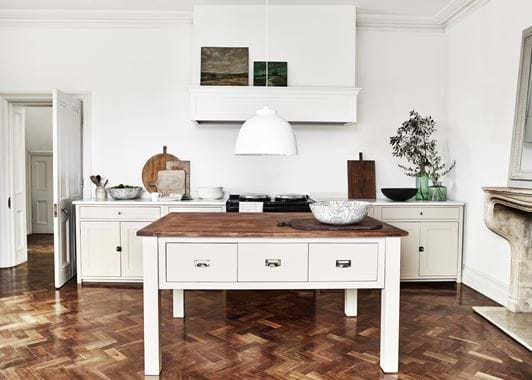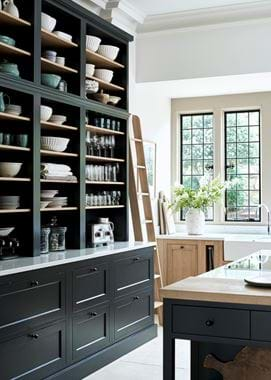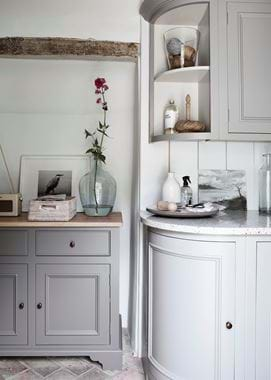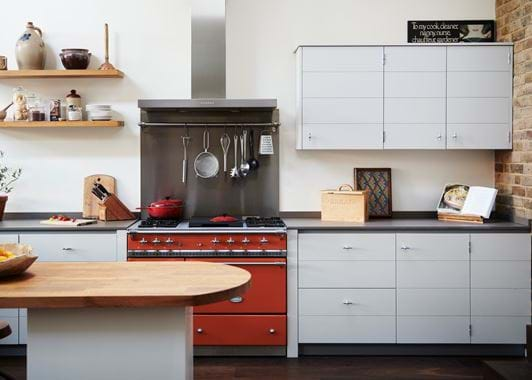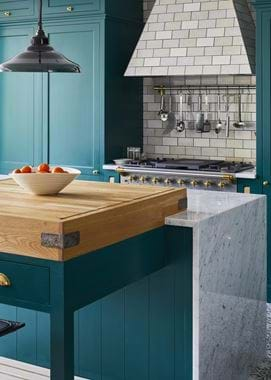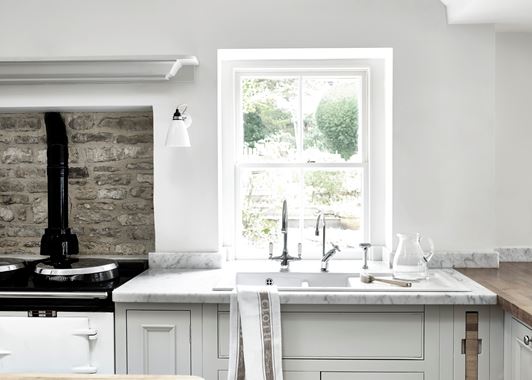Mixed media - the key to using different styles of work surface in your kitchen
Mixed media - the key to using different styles of work surface in your kitchen
When the time comes to renovate your kitchen, you’re likely to come across talk of mixing cabinet colours – the island in one colour and your fitted cabinetry in another, or the wall cabinets in a contrasting tone to the base. Remember though that contrast through colour isn’t the only area where you can mix things up. Read on to hear from a handful of Neptune kitchen designers as to why having two work surface materials can really work wonders.
Understand your material’s character
One of the principal reasons for having more than one type of worktop in your kitchen is for practicality.
“When you’re designing somebody’s kitchen, you’ll often find they have their heart set on a particular type of work surface, such as marble. But as you begin to get a clearer picture of their lifestyle and how they intend to use the kitchen, for example, they might be big cooks who love using spices, or red wine could be their go-to tipple, you can discover the two don’t go hand in hand. This is where I might suggest they have one section of the kitchen in marble, but in the key working or entertaining areas, something more robust like granite could suit them far more. A kitchen that you’re afraid to use isn’t what anybody wants. So, it’s important to remember that your character and that of your work surface’s need to be a good match,” explains Ami from Neptune Winchester.
A change in material allows for breathing space
Next up, aesthetics.
Like with any room in your home, there’s always a balance to be struck between function and form, but this balance is particularly true in kitchens and bathrooms. While the first point focuses on worktops and practicality, it’s true that mixing two types of work surface lends visual interest to the room too. It’s commonplace to have purely one material throughout, and so when you see quartz on one run and then oak on another, it’s unexpected, and so keeps your eye entertained.
“Sometimes, a client may be drawn to a bold, statement-making worktop, such as a dramatically veined marble, a jet black granite or a characterful piece of timber. As a designer, my role is to step back and imagine the effect this would have on the overall kitchen. Might it overwhelm? Might it detract from another lovely feature in a different part of the kitchen? Might the pattern or the colour give you a headache if it were used on a larger scale? If yes, I’ll advise they keep it to a small run, or just on the island, and then we pare things back with a more muted work surface elsewhere,” says Ashley from Neptune York.
Subtlety is equally as relevant as bold work surfaces though. The change in material need not be glaringly obvious, and in fact a discreet step change in texture and tone can make for an even greater surprise as it’s something you don’t immediately pick up on. This is something demonstrated in the Real Neptune Home pictured – Charlotte Marley’s Henley kitchen with quartz surfaces and a slim piece of oak atop of our potboard at the end of her kitchen island.
Think about your neighbouring surfaces
Considerations in worktops aren’t all about worktops. Stay with us on this one. When you're in the kitchen, it’s likely that you will have at least one piece of ‘unfitted’, freestanding furniture, be it a dining table, dresser, sideboard or console table. These too count as your kitchen’s surfaces, so think about the role they play in determining your principal material.
“I’ve designed kitchens where people have chosen our matte black Dekton surface (the finish is called Sirius). Even though it has a textured finish, which makes it softer than a smooth, polished one, some people fear it will look too strong and domineering in their space. This is where I might suggest bringing in an easygoing oak surface or two nearby to counteract it. A kitchen table is perfect if you have the room to spare, but otherwise, even the tiniest bit of visible oak surface on a dresser will lend a helping hand,” offers Hannah from Neptune Edgbaston.
Potboards and butcher’s blocks are worthy contenders too. You can even look at having them integrated into the adjoining work surface, as the teal Suffolk kitchen pictured shows.
An opportunity for creativity
And finally, inviting a second work surface style into your kitchen can also be an opportunity to go off script and source a more unusual material for a portion of the room.
“I’ve had some real fun with ‘non-standard’ work surfaces in my time. There have been people who wanted a very bold monochrome granite work surface for the food prep section of their kitchen, and another who had sourced a huge expanse of antique timber that they wanted to use alongside our marble. I always find these so exciting because it’s a real pleasure as a designer to create something as unique to the individual as possible, and creative worktop combinations are a fantastic way of doing just that,” says Hannah from Neptune Chester.
Discuss your kitchen design ideas with one of the experts at your local Neptune store. Book a free design consultation at your local Neptune store.

